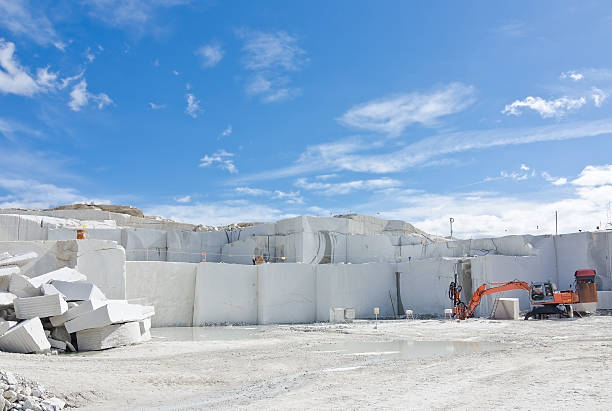A Trip With Granite Quarries in South Africa: Introduction Nature's Creativity
A Trip With Granite Quarries in South Africa: Introduction Nature's Creativity
Blog Article
Uncovering the Rich Background and Sustainable Practices of Granite Quarrying
As we base on the precipice of uncovering the detailed tapestry of granite quarrying, a journey via time exposes not simply the physical act of drawing out stone but additionally the social and historic importance woven into the extremely material of this method. From the old beginnings that laid the foundation for contemporary quarrying methods to the sustainable practices that are shaping the future of this industry, each sculpt mark on granite surfaces narrates waiting to be unearthed (granite quarries in south africa). The legacy of granite quarrying extends far beyond simple removal; it is a testimony to human resourcefulness, durability, and the enduring appeal of this stunning stone
Old Origins of Granite Quarrying
Going back to old civilizations, the practice of quarrying granite has actually been an integral part of human background and building advancement. The earliest evidence of granite quarrying go back to old Egypt, where substantial pyramids and complex sculptures were crafted from this resilient rock. The Egyptians utilized primitive tools to remove granite blocks from quarries, showcasing the value of this material in their significant building and constructions.
Moving onward in background, the Greeks likewise made significant payments to the quarrying of granite. The Greeks made use of granite in numerous architectural wonders, such as temples and statues, demonstrating their ability in shaping and sculpting this sturdy rock. The Romans better fine-tuned the techniques of quarrying granite, using sophisticated tools like blades and hammers to remove and form granite for their renowned frameworks.
Through the centuries, the method of quarrying granite has actually progressed, with contemporary innovations enhancing efficiency while preserving the timeless allure of this all-natural stone - granite quarries in south africa. From ancient human beings to contemporary home builders, the tradition of granite quarrying continues to shape our world
Advancement of Quarrying Techniques
The advancement of quarrying strategies has actually been noted by a continual progression in the direction of higher performance and accuracy in removing granite. From the fundamental methods used by our forefathers to the sophisticated innovations used in modern quarrying procedures, the market has actually undergone significant advancements. Early quarrying strategies entailed manual labor with basic tools such as blades, hammers, and wedges to extract granite blocks from the earth. As human beings progressed, methods like fire-setting and primitive nitroglycerins were presented to promote the extraction process.
Advancements in computer-controlled devices and 3D modeling have actually maximized quarrying operations, leading to minimal environmental influence and boosted sustainability methods. As the need for granite proceeds to climb, the advancement of quarrying strategies continues to be essential to conference market requires efficiently and sustainably.
Cultural Importance of Granite
Granite holds a profound cultural value throughout different civilizations due to its enduring presence in building masterpieces and respected monoliths. From the majestic pyramids of Egypt to the complex carvings of the Angkor Wat temple in Cambodia, granite has actually been a material of option for sharing majesty and durability in social heritage. In ancient Rome, granite columns decorated holy places and public structures, representing toughness and durability. The social importance of granite extends past its physical features; it symbolizes resilience, stability, and timelessness, making it a sign of enduring traditions and practices.

Lasting Practices in Quarrying
In the middle of the abundant background of granite quarrying and its social significance lies a growing focus on sustainable methods within the market. As ecological recognition and problems concerning source deficiency have heightened globally, the quarrying industry has actually significantly embraced lasting methods to lessen its effect on the atmosphere and surrounding communities.

Moreover, improvement and rehabilitation of quarry websites post-extraction are indispensable to lasting methods. By over here restoring quarried locations to an all-natural or useful state, such as creating wild animals environments or entertainment rooms, quarriers can offset the ecological impact of their procedures and add favorably to the regional community.
Heritage of Granite Quarrying
With a historical background soaked in workmanship and industrial progression, what withstanding effect has granite quarrying left on the landscape of modern society? The legacy of granite quarrying goes beyond mere removal techniques; it has formed architectural marvels, city landscapes, and social heritage worldwide. The resilient nature of granite has actually made it a recommended choice for monoliths, structures, and facilities, standing as a testimony to the skill and virtuosity of quarry workers throughout generations.
Moreover, the financial footprint of granite quarrying can not be overlooked. The industry proceeds to offer employment possibilities and drive go to this website neighborhood economies in areas where granite extraction is common. It has likewise spurred technical improvements in quarrying techniques and devices, resulting in extra effective and lasting techniques.
In regards to sustainability, the tradition of granite quarrying consists of efforts to alleviate ecological impacts through improvement tasks and accountable resource administration. By balancing economic interests with environmental stewardship, the industry strives to ensure that future generations can continue to gain from this long-lasting natural deposit.
Conclusion

Report this page